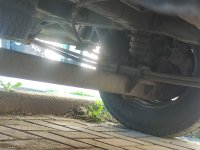Roadtonowhere
Member
Hi all,
Im looking to get some clarity on suspension types and the corresponding max weight for these vans.
I've got a 2009 3.0 liter, L2H2 van with a max weight of only 3000kg. On the typeplate it says front axle is rated at 1630kg, rear at 1650. Now, I have been looking at upgrading the suspension, and if needed the tyres and/or rims to possibly get up to 3500kg.
I suspected to have the single leaf spring in the rear as I have a 'light' van. But after inspection I sem to have the more heavy duty double leaf spring. On youtube there a plenty videos op people 'upgrading' theri single leaf suspention to a double one. The van also sits pretty high with plenty of room te spare under the bump stops and above the wheels.
On the front I cant make out what kind of suspention is installed. Is there a way to identify what suspention is curently on the van (front and rear) and for what axle loads it is rated?
Thanks!
Im looking to get some clarity on suspension types and the corresponding max weight for these vans.
I've got a 2009 3.0 liter, L2H2 van with a max weight of only 3000kg. On the typeplate it says front axle is rated at 1630kg, rear at 1650. Now, I have been looking at upgrading the suspension, and if needed the tyres and/or rims to possibly get up to 3500kg.
I suspected to have the single leaf spring in the rear as I have a 'light' van. But after inspection I sem to have the more heavy duty double leaf spring. On youtube there a plenty videos op people 'upgrading' theri single leaf suspention to a double one. The van also sits pretty high with plenty of room te spare under the bump stops and above the wheels.
On the front I cant make out what kind of suspention is installed. Is there a way to identify what suspention is curently on the van (front and rear) and for what axle loads it is rated?
Thanks!
- Year
- 2009




